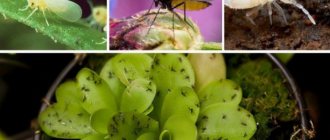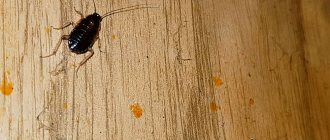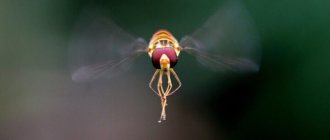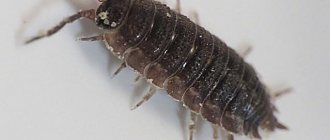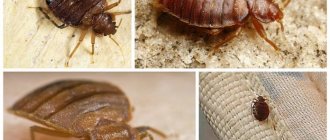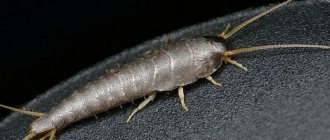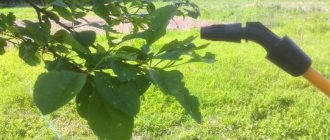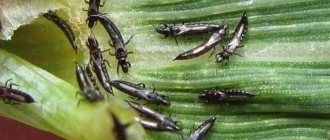Springtails are insects that can cause some damage to your indoor plants. But at the same time, they can be found not only in flower pots, but also in other corners of the apartment. Preferring dampness, these parasites make their home in the bathroom, and if there is an aquarium in the house, then they will get along quite well under its lid and their accumulations will be constantly observed on the surface of the water. How to get rid of these small bugs in each individual case? Let's find out.
Why do colonies of springtails attack indoor plants?
When watering, you can notice accumulations of collembola bodies on the surface of the soil and unabsorbed water.
They are tiny in size (0.25–6 mm), elongated or round in shape, and have 6 legs. Poduras are wingless creatures of gray, white, brown color that slowly crawl along the substrate and jump short distances. Springtails belong to the subclass Collembola. Representatives of this group of insects develop in the soil and feed on dead plant organs, fungi, algae, and bacteria. Springtails are capable of changing their diet and damaging tender parts of plants. They do not attack humans or animals.
In moist soils with a high organic content, at favorable temperatures, springtails multiply quickly. As soon as the earthen ball dries out, the body of the collembola begins to lose moisture. The entire colony goes in search of a wetter substrate.
Poduras enter the house from the street if the lawn or flower bed is dry. They penetrate through ventilation holes, cesspools, and any sources of moisture around the premises. In rooms where it is damp, they can even be found in furniture. As soon as the pockets of mold and moisture disappear, the springtails die or go in search of favorable places.
News:
- Whitefly
- Fungus gnats
- Earthworms
- Weevils
- Ticks
- Root mealybug
- Leaf rollers
- Honeyweeds, Leaf fleas
- Woodlice
- Miners
- Mining moths
- Mealybugs
- Nematodes
- Springtails
- Fruit flies, Drosophila
- Fruit and apple moths
- codling moth
- Moths
- Slugs
- Aphid
- Thrips
- Silkworms
- Earwigs
- Scale insect and false scale insect
- Enhytrea
Springtails (Collembola) and related podars are extremely widespread, especially in temperate latitudes, there are many of them in the tropics, they are found both in the Arctic and Antarctic - wherever there are at least mosses and lichens.
These insects most often live among rotting plant remains and in the surface layer of soil, but many also live deep in the soil, often penetrating deeper than other animals. Among springtails, there are also those that live on the surface of plants, and there are even those that have passed on to life on the surface of a film of water.
The number of springtails is also very large. For example, in the soils of forests and meadows, often on every
Those springtails that live on the soil surface can move in a very unique way. On the lower surface of the posterior end of the abdomen there is a special organ not found in other arthropods - the so-called “jumping fork”. In a calm state, it is tucked under the abdomen. Quickly straightening this “fork”, the collembola pushes off from the object on which it sits and makes a sharp jump.
Springtails that stay on the surface of the water (there are some) can jump, pushing off even from the surface film of water - their body is not wetted by water.
White springtails, which always live in the ground and do not appear on the surface, do not have a "jumping fork"; they can only crawl with the help of short chest legs, often not even noticeable when viewed from above. A number of springtails harm plants, such as green smintur or onychiura, which sometimes eat en masse into the succulent roots of greenhouse plants.
Some species probably cause harm indirectly by spreading fungal spores that cause plant diseases. In general, springtails are not only harmless, but even useful: they contribute to the decomposition, transformation into humus and mineralization of plant residues and, according to modern data, play a very important role in soil formation. So don’t rush to remove your springtail with the fury of a tiger, as the chemical may be more harmful to your pet than the springtail itself.
Control measures:
keeping plants in drier conditions; immerse pots with plants entirely in water, and then catch floating insects; Cut a raw potato in half and place the halves on the surface of the soil, cut side down. Springtails that get there can be easily collected and destroyed.
Materials used in the article:
G.E. Kisilev. Floriculture. Second edition supplemented. M.: State. Publishing House of Agricultural Literature, 1952. — 992 pages
https://www.botanichka.ru/article/springtail/https://dic.academic.ru/dic.nsf/enc_biology/236/%D0%9E%D1%82%D1%80%D1%8F%D0 %B4https://floralworld.ru/illnesses_wreckers/collembola.html
How to get rid of springtails and dura
The first thing you need to do to get rid of springtails or springtails is to properly dry the soil in the pot
This is especially important for the health of plants that do not tolerate stagnation of water in the roots, excessive dampness: dracaena, ficus, dieffenbachia, citrus fruits, gardenia, euphorbia, adenium, brunfelsia, billbergia, peperomia, gerbera, schefflera, azalea, etc. Most plants tolerate drying out - and you need to dry it until the pot becomes noticeably light. You can safely dry the soil in pots with ficus, schefflera, peperomia, succulents, dieffenbachia, lemon, dracaena to dust.
But some plants do not tolerate complete dryness; gardenia or azalea may turn yellow, lose leaves and die. Therefore, focus on the plants’ care requirements and external condition.
You can easily dry the soil in pots with ficus, schefflera, peperomia, succulents, dieffenbachia, lemon, and dracaena to dust. But some plants do not tolerate complete dryness; gardenia or azalea may turn yellow, lose leaves and die. Therefore, focus on the plants’ care requirements and external condition.
In addition, if the weather is very hot, above 26°C, sunny and dry, drying out the soil in a pot is difficult for any plants!
It is best to remove the plant from the pot and check for rotten roots; you may soon have to not only get rid of pests, but also treat diseases: root and stem rot and bacteriosis. You need to understand that springtails, springtails and springtails are an indicator of the condition of the earth. An indicator that you have a swamp in your pots.
There are plants that love dampness, for example, cyperus. But in pots with cyperus there are almost never springtails or springtails. Do you know why? Because the roots of Cyperus, despite the dampness, are healthy and not rotten! Soil bugs multiply where there is rotting organic matter.
So, figure out the state of the roots:
- if necessary, remove old soil
- cut off rotten roots
- dry the root ball, if necessary, in the shade on a newspaper, or by thoroughly blotting the roots with a ball of toilet paper
- Sterilize fresh soil, especially if you use garden soil
- after transplanting into fresh soil, take preventive measures against rot - water it with phytosporin (2-4 g per 1 liter of water)
- Don't overwater your plants in the future.
The first method of control: if it is not possible to replant the plants, for example, a palm tree, in the roots of which there are poduras, is planted in a large tub, then you need to water the soil with insecticides: actara, tanrek, Apache or any available drug for the Colorado potato beetle. Springtails are very resistant to insecticides, so a single watering and a weak concentration may not help; aktar, for example, needs to be diluted in 8 g per 10 liters of water. Anti-slug medications help get rid of springtails: for example, Grom-2. To do this, remove the top layer of soil (about 1 cm), sprinkle the soil with Thunder-2, and top with the removed soil, do not water until the next time.
The second method, if the use of insecticides is not available and drying the soil does not help, is to dust the entire surface of the substrate with ash, a very thin layer (the method is not suitable for plants that love acidic soil: azaleas, camellias, conifers).
Third method: remove the top layer of soil and pour 2 cm of clean, dry sand. Water until this layer of sand dries completely. There is no organic matter and little air in dry sand—pouras and springtails do not survive. But after 3-4 months you need to remove the sand and replace it with a layer of fertile soil.
Fourth method: watering the soil in the pot with hot water. Hot means about 65°C. Plants planted in the ground easily tolerate this procedure (except for orchids and ground cover). You need to water with hot water several times in a row as the next watering.
If fools are infested in a pot of phalaenopsis, you need to remove the orchid from the bark, rinse the roots in water, plant it in clean, non-rotten bark, cutting off the rot and drying the sections (with charcoal).
There are worms in the flower
Girls, what to do? I flooded the dracaena, if you loosen the soil, you can see that there is water inside, there is no water on the surface, just wet soil. and so on for several days. There were worms, like earthworms, only smaller. pot without tray, with drainage. I know that you can pour a solution of potassium permanganate, but I’m afraid, because... The pot is already flooded and the water does not come out of it. what to do?
Woman.ru experts
Find out the opinion of an expert on your topic
Olga Yatsenko
Psychologist. Specialist from the site b17.ru
Yana Vyacheslavovna Rom
Psychologist, Family consultant. Specialist from the site b17.ru
Bazhazhina Svetlana Vladimirovna
Psychologist, Coach. Specialist from the site b17.ru
Olesya Valerievna Baburina
Psychologist. Specialist from the site b17.ru
Natalia Andrushko
Psychologist, Eco-facilitator, Supervisor, Mediator. Specialist from the site b17.ru
Machneva Diana Olegovna
Psychologist, Integral neuroprogramming. Specialist from the site b17.ru
Sheludyakov Sergey
Psychologist, Clinical psychologist. Specialist from the site b17.ru
Khorina Elena Viktorovna
Psychologist, Perinatal psychology TOP. Specialist from the site b17.ru
Anastasia Dyadchuk
Psychologist, Phototherapist. Specialist from the site b17.ru
Vorobyova Yulia Nikolaevna
Psychologist. Specialist from the site b17.ru
land purchased? Or did you dig it yourself? worms will not come out of nowhere, especially earthworms
from worms and flies, a remedy will help you in flower shops, although this will not save your dracaena with such grief care (
that's why I don't like flowers
dig up, wash the roots in a solution of potassium permanganate and wash the pot and put it in new soil (it will hurt but there is a chance to survive))
sprinkle crushed inta-vir on top of the soil, it will die and do not water it for a longer time, you can also sprinkle it with phytosporin, just buy it in powder, it may help against rotting, then you can water it with the powder
and earthworms are not harmful, you just don’t know what you have there
Is there a hole for draining water in the pot? This is to prevent the water from standing. And to get rid of worms, it is better to transplant the plant into another pot with a radical change of soil. I recently did this at work with a sick office flower. She pulled out the flower, shook off as much soil as possible from the roots, and washed it in a bucket of water so that more soil was removed. I washed the pot with potassium permanganate and filled it with new soil. The second week has begun, the flower is doing well. I even released a flower arrow.
Moderator, please note that the text contains:
The complaint has been sent to the moderator
The page will close automatically after 5 seconds
New in three days
Popular in three days
Use and reprinting of printed materials from the woman.ru website is possible only with an active link to the resource. The use of photographic materials is permitted only with the written consent of the site administration.
Posting intellectual property objects (photos, videos, literary works, trademarks, etc.) on the woman.ru website is permitted only to persons who have all the necessary rights for such posting.
Copyright (c) 2016-2019 Hirst Shkulev Publishing LLC
Online publication “WOMAN.RU” (Zhenshchina.RU)
Certificate of registration of mass media EL No. FS77-65950, issued by the Federal Service for Supervision of Communications, Information Technologies and Mass Communications (Roskomnadzor) on June 10, 2016. 16+
Founder: Limited Liability Company "Hirst Shkulev Publishing"
How to recognize collembola?
The size of springtails ranges from 0.2 mm to 10 mm (very few species). Springtails prefer a secretive lifestyle in places with high humidity. They live in the soil, under the bark of dead trees, in leaf litter, and in cracks in stones. Springtails feed on fungal mycelium, bacterial plaque, algae, mosses, and lichens. Only a few species can feed on higher plants. Unfortunately, this is exactly what flower growers are faced with.
Identifying these representatives of the animal world is quite difficult. There are many views on the taxonomy of springtails, as a result of which many synonymous names are mentioned in the literature.
The small size and secretive lifestyle of springtails make it difficult to study them. The lack of accessible and complete identification literature on these groups of insects makes it almost impossible for non-professionals to identify springtails.
Fortunately, the biology of soil springtails is similar enough that precise identification is not required. It is enough to know that these are springtails and not to confuse them with other insects (thrips, rootworms) and mites. To develop adequate control measures, if necessary.
Water springtail, or water forktail (Podura aquatica). Michaelson J
Entomological classification
As is often the case, when talking about fools, flower growers do not mean real fools, insects of the family Poduridae (Podurids), but their closest relatives - springtails from the families Hypogastruridae and Entomobryidae, subclass Collembola (Collembolas). Collembolas are a order of cryptomaxillary, which includes about 8 thousand species.
Real fools do not live in the soil of indoor plants at all; their habitat is ponds, puddles, and swamps. Their diet consists of simple fungi, mosses, lichens and algae. But the springtails Hypogastruridae and Entomobryidae are our home flower lovers. But, since this is how it is, we will continue to call springtails fools.
Fools - appearance
How can you tell if your flower is full of fools?
Poduras look like small white or cream-colored caterpillars with short antennae. There are specimens painted in a greenish or silvery tint. The size of the insects is approximately 2 mm, in some cases it can reach 1 cm. A special fork is attached to the underside of the abdomen, thanks to which the podras can not only crawl on the soil, but also jump, pushing off the surface with the fork. It is by this feature that an inexperienced gardener can distinguish the dur from other pests, such as mealybugs.
Beginning gardeners confuse podur not only with mealybugs, but also with insects such as fungus gnat larvae or thrips. But although all these insects are white or cream-colored, it is very easy to distinguish springtails by their ability to jump on the surface of the soil.
Podura larvae look approximately the same and differ from adults only in size.
How to get rid of springtails?
Podura are almost always present in volumes with mature plants, and it is not necessary to conduct a directed fight against them with normal agricultural technology. The main measure to combat outbreaks of podar numbers can only be compliance with the conditions of correct agricultural technology for growing plants.
The substrate should not contain a large number of actively decomposing components (unrotted leaves, tea leaves, decorative sawdust). The volumes must have good drainage to prevent stagnation of moisture in the soil. Watering is moderate, as the soil dries. The volume of the pot should correspond to the size of the root system. The place not occupied in the near future by plant roots will be occupied by fungi, bacteria, algae, the earth will turn sour, and fools will breed.
The number of duras remarkably restrains a number of predatory mites, which are also almost always present in the soil.
If there are too many springtails, change the soil to a new one. If history repeats itself, then reconsider the soil composition and watering regime.
In cases where you need to take urgent measures to reduce the number of poduras, you can use systemic insecticides (Mospilan, Aktara, etc.). You can restrain and somewhat limit the number of fools by also adding citramon or askofen to the water for irrigation (half a tablet per 2-3 liters of water).
Centipede from the class Symphyla and springtail Poduromorpha.
When sowing Saintpaulia and Streptocarpus seeds, the soil must be thoroughly steamed. The container in which the seeds are sown must be sealed and have no drainage holes accessible to the pest.
It is especially important to comply with these requirements when there are few seeds, or the germination capacity of the seeds of a given hybrid is very low.
How to protect your garden from pests mechanically
Many pests and diseases can be eliminated by mechanical measures. Reduces the number of pests and the stock of fruit rot infection by removing and burning winter nests of hawthorn and lacewing, mummified fruits, collecting in hunting belts with the subsequent destruction of apple and plum moth caterpillars, regular collection of carrion, removing spider nests with hatched apple moth caterpillars.
To protect your garden and vegetable garden from pests such as weevils (cherry elephant, apple blossom beetle, brant, beetle), in the spring, before trees and shrubs bloom, you can shake insects onto film or canvas using wooden beaters covered with burlap. The beetles are collected in a bucket with water and a small amount of kerosene. Shake off early in the morning while it's cool. At air temperatures above 10° C, the beetles fly away.
When red and white currant leaves bloom, currant leaf aphids can be eliminated by regularly picking off and destroying leaves with red spots as they appear.
During flowering, terry currant bushes are clearly visible; they need to be removed and burned.
It is also recommended to hill up the bushes to protect the garden from insects. Hilling up currants and gooseberries in the fall (unhilling after flowering), as well as covering the soil under the bushes with roofing felt or plastic film, makes it difficult for the gooseberry moth to fly out. Regular collection of moth-damaged currants and gooseberries entangled in cobwebs reduces the number of the pest. Gooseberry sawfly larvae on gooseberries, red and white currants can be shaken onto a film or umbrella by tapping the shoots with a stick.
When regularly collecting apple and plum carrion, caterpillars of apple and plum moths, almond seed-eater larvae and other pests, causative agents of scab and fruit rot die. Carrion unsuitable for consumption should be buried in the soil to a depth of at least 50 cm or steamed and fed to livestock.
To protect plants in the garden throughout the summer, you need to identify and remove raspberry bushes that are sick with curling and sprouting, carefully selecting rhizomes. Young currant bushes can be healed from spheroteca with hot water - in the fall, after leaf fall (October), pour water on the bush from a watering can at a temperature of 72 - 73 ° C, in the spring, before the buds open, this technique can be repeated.
Damage caused by fools
If there are few insects, then you should not expect much harm from them. If the number of springtails increases sharply, the risk of losing the plant increases.
Nature of the negative impact:
- When conditions are particularly favorable, and this is possible at an ambient temperature of +22 to +25 degrees and high humidity, podars multiply quickly. At the same time, they begin to occupy the entire plant, penetrating even into the soil. They not only suck the juices out of the plant, but also gnaw on green shoots.
- When the root system is damaged and the plant begins to receive less nutrients, it stops developing.
- In addition, the affected areas of the plant are a kind of gate through which various bacteria can penetrate.
Signs of infection
It is not difficult to determine that an indoor crop has been affected by a dangerous parasite. This will be highlighted by several symptoms:
If the soil moisture increases significantly, a whitish coating will form on its surface. This is where small insects are kept.- Mature individuals, with a two-millimeter body, lead an active lifestyle, jumping in every possible way and demonstrating their activity.
- The elongated body of podurs can have different colors: from white to brown.
- Small creatures quickly move to the upper parts of the flower, spending much of their time in the surface soil layers. Active reproduction of the colony, deterioration in temperature and moisture levels contribute to the rapid “occupation” of roots and leaves, from which the podurs suck out the nutritious juice.
Currently, scientists identify several main varieties of springtails: white, vegetable, and mushroom. Representatives of the first species eat the top soil layer and often attack greenhouse and greenhouse plants grown in conditions of high moisture. Vegetable pests are a danger to all ornamental plantings that grow indoors. They interfere with the normal formation of green mass and stop their normal development.
As for fungal pests, this species affects young shoots, seedlings of champignons and bulbous flowers.
Effective methods of control
The main thing is to figure out why springtails appeared at home, in open or closed ground. The main reason is excess soil and air moisture. To combat pests, you will have to eliminate the factors that attract insects.
How to proceed:
Folk remedies and recipes
It is not difficult to repel pests from orchids, violets, and camellias when using natural ingredients. Flower growers share their secrets of fighting tiny parasites.
Proven methods:
potato bait. The method is simple: divide the raw tuber into two halves, place the potatoes cut side down, and check the trap after 3-4 hours. Tiny insects actively gather around potatoes. The owners should quickly cover the piece of tuber with a bag or glass and remove the container along with the insects
It is important to act quickly, carefully, and remember: springtails on orchids, gloxinias, azaleas do not stay in one place for a long time, they jump to a new area,
wood ash against poisons. A good remedy for reducing the number of pests and reducing soil moisture
Directions for use: spread ash no more than 1 cm over the soil surface, reduce watering, reduce air humidity to optimal levels. For azaleas and camellias that prefer soils with high acidity, you should not use a natural component.
Preparations to combat springtails
Traditional methods are effective and safe for plants, but when the colony is large, potato baits and sprinkling the soil with wood ash do not give the desired result. Parasites actively gnaw at the roots, suck out the juices, and the plant weakens before our eyes.
In a difficult situation, it is important to treat the flower with proven drugs in a timely manner. Find out how to remove food moths from the kitchen using folk remedies and chemicals
Find out how to remove food moths from the kitchen using folk remedies and chemicals
Find out how to remove food moths from the kitchen using folk remedies and chemicals.
How to provide first aid and how to treat allergies to insect bites is written on this page.
Go to https://parazitam-stop.com/sad/rastenija/kapustnitsa.html and read about the reasons for the appearance and rules for controlling the cabbage butterfly in the garden.
Effective compositions for combating springtails:
Dimilin. Low-toxic product, active ingredient – diflubenzuron 250 g/kg. Broad-spectrum insecticide, insect growth regulator. Release form: wettable powder. A new generation drug with a residual effect of up to 40 days. The product is safe for people and animals (you should still not forget about measures to protect the skin, respiratory organs, and eyes), and quickly decomposes in water and soil. Regent. The product contains the active component fipronil, which disrupts the transmission of nerve impulses, causing paralysis in harmful insects. A contact-intestinal insecticide destroys a colony of pests in a few days. The drug is sold in two forms: ampoules with concentrated liquid and powder
When processing the soil, be careful; be sure to protect your eyes, respiratory organs, and skin from drops of the solution. Bazudin. A long-acting drug protects plants from many soil pests
A long-acting drug protects plants from many soil pests
Bazudin. A long-acting drug protects plants from many soil pests
Active substance – diazinon, 100 g/kg. A hazard class 3 product with a pungent odor. Granules have a complex effect on parasites and pests. To kill insects in flowerpots with indoor flowers, dig granules to a depth of 1 cm. Podurs die within a day after using the drug, the residual effect lasts up to six weeks. A contact-intestinal insecticide with translaminar action does not harm plants.
Preventive measures
After removing tiny parasites, amateur flower growers and greenhouse owners must draw conclusions. By eliminating factors that attract harmful insects, the risk of the appearance and active reproduction of springtail springtails is noticeably reduced.
How to proceed:
- reduce watering, eliminate excess dampness in the room;
- create a good drainage system for regular water flow;
- Fertilize flowers with coffee grounds and tea leaves no more than once a week. Make sure that natural components do not rot on the soil surface;
- do not allow stagnant water to accumulate in the pan;
- look into flowerpots more often, loosen the soil, remove fallen leaves;
- in case of soil salinity or moss proliferation, remove 1–2 cm of soil and replace with fresh, high-quality substrate;
- treat the soil with herbal preparations every two weeks and spray the soil with bactericidal agents for prevention;
- sprinkle the soil with tobacco dust or sand. Layer – no more than 0.5–1 cm;
- After destroying the pests, it is advisable to replant the flower. It is important to equip a good drainage system in the pot, buy high-quality soil in a specialized store;
- activated carbon helps treat damaged areas of the root system;
- adhere to the rules of caring for a certain type of plant, do not oversaturate the soil with moisture;
- If you suspect the proliferation of dangerous parasites, immediately isolate the indoor flower and inspect not only the above-ground part, but also the soil. Many pests live among the root system.
In closed ground it is difficult to deal with high humidity; you will have to use natural components and biological products to protect plants more often. At home, it is easier to create an environment where pests cannot exist. It is important to remember that excess moisture attracts not only springtails, but also other insects: midges, brown carpet beetles, ants. Dampness attracts twotails, centipedes, woodlice, and mealybugs.
When springtails appear on indoor flowers, in a greenhouse or open ground, you need to stop excessive watering of the plants. It is dampness, stagnation of liquid in trays, and rotting of moistened organic fertilizers that provoke the reproduction and rapid increase in the colony of durs. Proper flower care, folk remedies, and insecticides will save amateur flower growers from encountering tiny insects in flowerpots with orchids, violets, and azaleas.
Who are springtails, how to recognize them and how to deal with them? Useful tips for flower growers in the following video:
Benefits and harms
It's time to present the arguments for and against springtails. There is something in us humans that makes us attack and kill even the most harmless creatures just because we don’t like their appearance, or accidentally crossed our path. All of the above also applies to springtails - these are completely harmless creatures.
However, there is a problem, and it needs to be solved, so first we will describe the negative side of this insect.
Harm
What forces us to fight collembola is not the threat of being bitten or the threat to our food supplies. No, this is ordinary disgust, which can lead some people to panic.
Of course, it’s unpleasant if you find a herd of springtails in your apartment. Instead of just collecting them and throwing them out into the street, we will begin to fight them.
Naturally, the most favorite places in our home for springtails are damp rooms: the corners of the kitchen under the sink, the corners under the plumbing fixtures in the bathroom. Particular accumulations are observed in areas of leakage. There, under constant drops of water, mold forms - the favorite food of fools.
The appearance of springtails in a sparkling clean bathroom is perceived by people as something terrible, and the hand itself reaches for a bottle of Dichlorvos or another similar product.
The second case of sabotage can be observed on indoor plants. Here, springtails can crawl along the soil in a pot, and especially impudent individuals can even try to gnaw on the leaves. Of course, here too it is necessary to take measures for destruction.
Benefit
Before we start fighting collembola, even in a separate article, we’ll tell you about the benefits these amazing creatures bring. Here we can observe two sides of the insect's usefulness.
Firstly, by eating tons of dead organic matter, springtails transform it into exactly that substance that all gardeners adore - humus. The feces of these insects are almost ready-made food for microorganisms, and the products of subsequent decay are already absorbed by our plants. Therefore, the more different small creatures in your garden bed, we mean not only springtails, the faster the dead organic matter will work to increase soil fertility.
The second benefit of springtails is their use as food for aquarium fish, reptiles or amphibians. Special websites for lovers of exotic fish even describe methods of breeding springtails, as they say, “for livestock feed.” They advise feeding them potato peelings.
How to deal with an invasion
Preventive measures
Moisture attracts springtails
When looking for damp places, springtails from the street can get into a damp room, which means this needs to be prevented. It is difficult to “live” such a tenacious insect, but not to create favorable conditions for it – perhaps the following measures will help with this:
- Ventilating the room will reduce air humidity.
- How to get rid of springtails in the bathroom and basement? First of all, install fans and clean with soap or soda solution.
- Eliminate possible sources of mold or mildew (leaking faucets, faulty old water and sewer pipes, cracked window frames or wooden window sills).
- Disinfection of the toilet room with chlorine-containing products.
- When watering indoor plants, do not exceed the watering norm and make sure that water does not stagnate in the flower trays, and that the lump of earth in the pot does not resemble liquid mud. If this happens, drain the excess water, place a sponge on the ground for a while, and then let the soil dry.
People against springtails
If preventive measures do not help prevent the appearance of insects, then the “enemy” will have to be destroyed. The safest are traditional methods, so you need to start with them.
A small population can be destroyed with improvised means
Wood ash is an excellent control method, but it is not suitable for all indoor plants. It is strictly forbidden to use on azaleas, hydrangeas, camellias (they grow on acidic soils). Instead of ash, the ground around them is sprinkled with mustard powder. Insecticidal plants. It is recommended to water the soil around the flowers with infusions of hot pepper or yarrow. A weak solution of potassium permanganate will help cope with insects. The following manipulations will help you get rid of springtails in your apartment: place a flower pot in which insects are found in a bucket of water. After a while they will float to the surface - you need to catch them with your hands and destroy them. A very simple and, according to reviews from Internet users, an effective way to combat insects: place the cut half of a potato on the ground in a flower pot, cut side down, leaving for several hours
Then, carefully remove the potato, destroy the gathered springtails and set the “trap” again. Wet potato slices are an excellent treat for pests. Another elementary way
Dissolve 2-3 tablets of Citramon or Askofen in two liters of water and pour the solution onto the ground around the flower. The plant is not harmed.
These drugs really work
Before using various chemicals, you need to remember that some can harm the plant itself, so be sure to read the instructions before use. But, in general, plants are not afraid of the effects of insecticidal preparations. The main thing to remember is that since these arthropods inhabit the earthen ball, the fight must be waged by cultivating the soil, not the plant.
Regent is popular in the fight against domestic insects
Insecticidal preparations for effective control of collembola:
- “Pochin” - a granular preparation is mixed with the top layer of soil in flower pots. At the same time, the soil must be dried. The drug has a rapid effect.
- "Regent" - in granules. The active ingredient fipronil remains in the ground for a long time, protecting the plant.
- “Bazudin” - the action of the drug granules, which are poured onto the soil surface, occurs very quickly. After a few hours, all pests are destroyed.
- “Dimilin” is a hormonal drug that has a stopping effect on the development of insects at any stage. This is an environmentally friendly product, which is indicated for use in premises where mushrooms are grown and from where springtails can be transferred into the apartment.
- "Aktara" - has effective properties. It is used both for watering the soil and for spraying plants. The protective effect against insects living in the ground lasts up to 60 days. Therefore, if treatment with this drug was carried out and after a while, the insects did not show themselves, the pest control can be considered over.
Have you found jumping springtails in your flower pots or bathtub? Carry out preventive measures (let the earthen clod dry, disinfect the bathroom) and annoying insects will most likely leave your apartment. If prevention is no longer effective, start a more radical fight!
{SOURCE}
Prevention
To avoid the appearance of insects in the bathroom, just follow these recommendations:
- Do some minor repairs. Once you've painted, sealed all the cracks and cracks, and sanded the grout, there will be fewer hiding places and ways for pests to enter your home. It will also lower the humidity level.
- Maintain good hygiene. Do not leave wet towels, rags, or scraps of paper on the floor. Clean regularly. Treat seams and crevices with disinfectants. Use bleach once a month when cleaning.
- Determine the humidity level and temperature. To do this you will need a thermometer and a special device. Measurement of indicators should be carried out within 3-5 days. If small bugs appear in the bathroom due to humidity and heat, it is necessary to constantly ventilate the room. If necessary, install a fan to promote air circulation if the ventilation in the bathroom does not cope with this task.
- Do not dry wet clothes or towels on the pipes. Moisture enters the air and settles on surfaces.
- Avoid condensation. If it does form, arrange forced drying and ventilation.
Fighting methods
Folk remedies
How to get rid of fools at home? If a small number of poduras appear in the substrate, do not rush to use chemical plant protection products; they can cause more harm to the orchid than a few insects.
When pests appear, the orchid should first of all:
- Isolate to prevent the spread of dura to other plants;
- Mechanical soil cleaning is carried out.
Good results can be achieved:
- Laying out bait in the form of raw potatoes cut into pieces on the substrate around the plant. In a few days, a large number of springtails will accumulate on it, which are easy to collect and eliminate;
- When immersing a flower with a pot in water for 20 minutes. All adult individuals will float to the surface in the water, after which they are collected and destroyed.
In addition, there are a number of other home methods to combat these insects.
Herbal decoctions of medicinal herbs. These decoctions have long been prepared to combat various harmful insects:
- Flowers of chamomile, calendula, dandelion, yarrow. To prepare a decoction, add 0.5 liters of water to 20 g of dry plants, bring everything to a boil and remove after ten minutes. Cool at room temperature, filter and treat the affected plants;
- Infusion of marigolds. Faded marigolds along with the leaves are poured with hot water in a 1:1 ratio and left for two days.
After treating the orchid with herbal decoctions, you should record the date of spraying in order to repeat the procedure after 7-10 days.
Herbal infusions are made against fools.
You can also use other solutions:
- Mustard solution. To prepare the solution, mustard powder (15 g) is poured into 1 liter of hot water and infused for 2 days. The resulting preparation is sprayed onto the plant, and dry mustard is sprinkled onto the soil;
- Mulching the soil with birch wood ash. A good result in the fight against springtails is obtained after sprinkling the soil with wood ash (birch ash is best) in a layer of one or two centimeters;
- Anti-flea shampoo for animals. A solution with the addition of flea shampoo showed unexpected effectiveness. To prepare 1 tbsp. l. shampoo is dissolved in a bucket of water, the plant and substrate are sprayed. After a short time after treatment, the orchids disappear.
The listed measures, which are used individually or in combination, are sufficient to protect indoor plants from any number of springtails.
Fitoverm
Fitoverm is a natural pesticide that is obtained during microbiological cultivation of the producing fungus. The drug is environmentally friendly, as a result of which its effect on the orchid will be minimal:
- The insect absorbs the drug along with food, as a result of which the poison affects only mature individuals and larvae. Podura eggs remain viable after treatment with phytoverm, so after 6-7 days it is necessary to spray again;
- Fitoverm is not mixed with other insecticides or fungicides.
To spray an orchid, 2 ml of the drug is dissolved in 50 ml of water, 0.1 liter of solution is consumed per plant.
Chemicals
If it was not possible to get rid of the larvae and adults using the methods described above, then you should use chemicals. Currently, there are a number of agents that have shown effectiveness against springtails:
- Bazudin is a powdery product; a thin layer of it is scattered over the surface of the substrate. As a result, after just a few hours, springtails will no longer annoy the plant;
- Pochin - used similarly to bazudine. To increase the efficiency of the process, the scattered preparation is mixed with a small amount of earth;
- Aktara is a universal drug, used in the form of a solution, which is used to water the soil and dilute it according to the instructions;
- Mospilan is also used to treat soil against podura in the form of a solution.
Chemical agents effectively help in the fight against fools.
These drugs will help control pests in a short time.
Precautionary measures
When working with insecticides, it is necessary to comply with safety rules:
- Children and pets are not allowed near the sprayed orchid;
- Work with insecticides is carried out with gloves and a respirator;
- After finishing work, the tools are thoroughly washed and stored in a separate place;
- In case of contact with skin, the insecticide is washed off with water and detergents. If the product gets into the eyes, rinse with running water;
- It is prohibited to eat or drink while carrying out work.
Used ampoules or packaging are wrapped in polyethylene and thrown away, the remaining solution is poured down the drain.
Bathroom
If the springtail has settled in the bathroom, then measures to combat it may be as follows:
- First of all, try to reduce the humidity in the room, and if you succeed, then with a high degree of probability the insects will either leave it themselves or die and you won’t have to do anything else.
- Using a regular fan, increase the flow of fresh air - this will eliminate dampness.
- In places where there is high humidity, mold and mildew that the collembolas feed on should be removed.
- Make sure that all pipes and other possible sources of water leakage are repaired. The most common cause of springtails in the bathroom is leaky pipes.
- Before using chemical insecticides, try using natural ones, such as a soap solution. To prepare it, combine a small portion of soap (a tablespoon) and water (half a liter) in a bottle with a spray bottle, then treat all areas where collembolas have been spotted with the resulting liquid.
On a note! Springtails are very small, so simply sweeping them out of the bathroom with a broom will not work. The best option is a soap solution!
In general, getting rid of springtails in an apartment is not that difficult. It is enough to ensure good ventilation in all rooms, seal cracks in window frames and door frames, and also monitor the tightness of window sills. These simple measures will not allow moisture to penetrate your home, and accordingly, will protect it from the elements.
If you live in a private house, then constantly monitor its wooden parts and replace damaged wood in a timely manner. A waterproof finish will help prevent cracking. If you find springtails, purchase a special insecticide that is used to treat external walls and use it in areas where the pest lives.
Advice! It is better to treat the outer walls and the adjacent area in the afternoon, or in the evening, but only before dusk, when the springtails are still quite active!
This way, you can eliminate the source of the infection. Such preparations can also be used for prevention, creating an external barrier that will destroy insects trying to get inside the house.
Sometimes, when watering indoor plants, feeding fish, or everyday visiting the bathroom, owners of houses and apartments encounter an incomprehensible insect that often jumps like a flea. As a rule, such meetings plunge us into shock; the thought of inevitable harm to property appears, not to mention natural disgust. Today we will talk about springtail, the reasons for its appearance and methods of combating it.
Fighting methods
The appearance of padura indicates excessive soil moisture. And this is already harmful for plants, in which the process of rotting can begin. Often, to get rid of these insects, it is enough to reduce the watering level and wait until the soil dries out. But this method is effective only if there are not too many springtails.
If you have indoor plants
As for indoor plants, the fight against padurs takes place without much effort:
- the flower is transplanted into another soil and a good drainage system is provided so that the water does not stagnate;
- Springtails are collected by hand. To do this, the pot with the plant must be completely immersed in water. All insects will float to the surface;
- watering is temporarily stopped and the top layer of soil, about 4 centimeters thick, is removed. Then sprinkle with dry sand;
- The plant must be planted in a pot of suitable size. In excess space, fungi and bacteria can multiply, serving as food for padura, which contributes to its development;
- You can put potatoes cut in half, cut side down, in the pot. After some time, springtails will penetrate into it - they need to be removed along with the potato;
- Paduras do not like citrus fruits, so drying their peel in a flower pot will force insects to leave the place;
- half a tablet of citramone or askofen per 3 liters of water - watering with such a solution will slow down the process of insect reproduction.
You can also use chemicals, but often this is not necessary at home. Moreover, most of these drugs are toxic and unsafe for human health.
In the garden
Poisons are applicable against springtails in open spaces. If the number of these insects in the garden is off the charts, and the roots of the plants are already significantly damaged, you cannot do without chemicals. For treatment, powder or granular insecticides are used, less often liquid
Act according to the instructions, observing safety precautions. Here are some options:
- “Aktara” – dissolve 1 g of the drug in 10 liters of water. Water the soil with this solution;
- “Bankol, SP” – dissolve 5-7 g of powder in a small amount of water. Mix this solution with a bucket of water. Use for watering;
- “Grom-2” – distribute granules evenly on the soil surface at a rate of 10 g per 1 square meter of area.
Usually, a one-time chemical watering is enough to completely destroy springtails. If there are a large number of insects, the procedure can be repeated after a week.
It should be remembered that the appearance of padura can be easily avoided by resorting to preventive measures. For example, before planting a plant, the soil can be watered with hot water, which will kill the germs of insects. By maintaining proper watering and a balance of organic fertilizers that provide food for springtails, you can be sure that they will not become a problem for your plants.
Reasons for appearance
These small insects are attracted to suitable conditions where excess moisture prevails, so they can be found in flowerpots where orchids, camellias, gloxinias, azaleas, violets, etc. grow.
What attracts these tiny pests:
- High soil moisture in pots when owners of indoor plants water them excessively.
- High humidity in the room where the plants are located. For the same reason, springtails settle in greenhouses.
- Decayed remains of organic fertilizers in flowerpots. As a rule, this happens when lovers of house plants feed them with tea leaves and do not remove it in time.
- The room is cold and damp.
- As a rule, during periods of dormancy, plants are weak.
- Moss on the soil surface. Such conditions are comfortable for the life and reproduction of springtails.
- The use of other organic matter that decomposes. Often, amateur gardeners use coffee grains, tea leaves and fermented milk products.
- An accumulation of fallen leaves in plant pots, which indicates insufficient plant care. The presence of organic substances on the soil surface, along with high humidity, provokes the development of various pathogens.
Routes of infection:
- With contaminated soil, when a person buys a flower in a store or takes soil for a flower from the nearest flower garden.
- When the soil on the street dries out, insects look for places with high humidity and enter a person’s home.
- With a plant that is bought at a flower shop or market.
